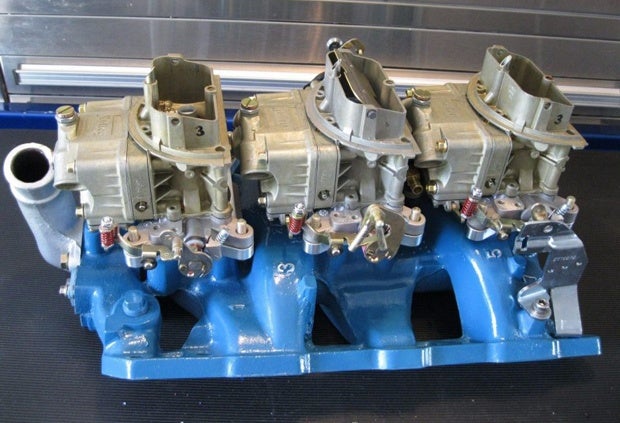A General Motors exec has just said that the Tripower name that was synonymous with Pontiac performance in 1966 is coming back for the Chevrolet Silverado and GMC Sierra pickup trucks. So let’s take a look at what Tripower was, and how it worked.
The new system was revealed by GM exec Mike Anderson at an industry event yesterday. This time, Tripower is going to be a suite of tech features designed to boost fuel economy. On the new 2.7L turbocharged four-cylinder engine, Tripower will mean things like cylinder deactivation that can turn off two of the cylinders. Active thermal management that can increase or decrease temperatures in various parts of the engine to keep it running at its most efficient. And variable intake lift that changes how long the intake valve stays open at certain engine speeds, improving fuel economy.
If none of those things remind you of the Pontiac GTO, we’ll forgive you. They don’t remind us of that vintage power either.
So here’s a look at the real Tripower, and how it works. And to be fair to GM, it was a system that could help fuel economy.
Pontiac launched Tripower–which seems to get labelled Tripower, Tri Power, or even Tri-Power depending on where you look–in 1957. That year, Chevrolet’s small block gained mechanical fuel injection that boosted power to one hp per cubic inch of engine displacement. Pontiac needed something to compete.
The Pontiac 347 (5.7L) was new that year. It could be had with two and four-barrel carburetor setups. Or, you could get the new hot option. Tripower. It replaced the fuel-efficient but slow two-barrel and powerful but thirsty (and not always the most driveable) four-barrel carbs with a seemingly simple compromise: Three two-barrel carbs.
ALSO SEE: 2019 Chevy Silverado Gets a Turbo Four With 310 HP
So how did adding more barrels increase fuel economy while adding power? It’s simple, but complex. Carburetors work best within a limited range. Move outside of that range, and they start to either run lean or dump fuel. A carb that’s set up to run well at low load and low throttle openings can’t accurately meter fuel when the engine is gulping down air. Likewise, one set up for big power can’t handle the requirements when the car is poking along on the highway. It tends to let more fuel flow than the car needs. Technology at the time also limited just how much fuel a single four-barrel carb could flow.
The Tripower traded fuel flow compromise for mechanical complexity. It had three two-barrel carbs, and a complex linkage connecting them. Drive normally, like highway cruising, and only the center carb’s throttle plates are used. The outer pair are basically along for the ride.
That allows for fuel-efficient cruising and excellent drivability at low loads.
Floor the gas, and things get more interesting. A linkage to the two outer carbs engages with the extra throttle travel and snaps their butterflies open. Now the engine can flow more air and more fuel than a smaller four-barrel. But it does it without the low-load sacrifices. For the first few years, that extra opening was vacuum controlled. When there was low vacuum (wide-open throttle) in the intake manifold, a solenoid opened the outer carbs. Later systems used a mechanical linkage that would open the outer carbs at wide throttle openings.
So the outer carbs stay closed when you’re easy on the pedal but open when you press the pedal down farther. The outer carburetors are also designed differently than the center unit. Most carburetors allow some air to pass through, even with the throttle closed. It’s how they idle. The outers on a Tripower setup use a thicker butterfly that is designed to fit tightly against the bore. No air can come through. If air was able to pass through the outer carbs with the throttle closed, it would act like a vacuum leak. Extra air gets in with no extra fuel. The engine would run rich and inconsistently, becoming very difficult to tune.
In 1957, the two-barrel 347 made 244 hp, the four-barrel made 270, but the Tripower made an impressive 290 hp and 375 lb-ft of torque. Later and larger versions of Pontiac’s V8s made up to 376 hp. The design was used across the Pontiac lineup, and found its way under the hoods of Chevrolets, Oldsmobiles, as well as Buicks.
ALSO SEE: Light Duty? Lucky Draw? 2019 Chevrolet Silverado 1500 LD
Naturally, there were badges and logos and stickers to tell everyone in a 10-mile radius that you were driving a Tripower Pontiac.
Developments in carb tech, along with the complexity of tuning a three-carb system meant that it didn’t stick around past the 1970s. Ford and Chrysler tried similar systems, with the Chrysler six-pack being the most notable. It used all three carbs all the time, though, for outright power over fuel economy.
So maybe the new system will add power to the 2.7L turbo. Enough to give it more power than the V8s that launched the name. But we’re sorry, it will never be as cool as the three-carb Tripower setup that launched in 1957. The new trucks had better at least get a cool fender badge.
This article originally appeared on GMInsideNews.com


 Your Privacy Choices
Your Privacy Choices